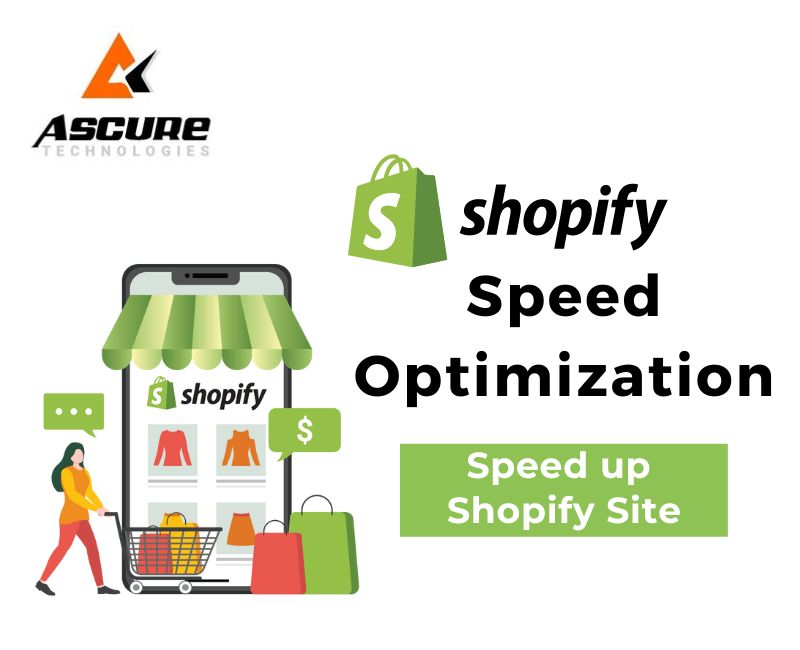
Shopify Speed Optimization
You might have come across or heard the famous idiom “Slow and steady wins the race” However, when it comes to Search Engine Optimisation, it doesn’t fit. In the E-commerce world, people value the phrase “Time is Money” more perfectly because the loading time of your Website is directly proportional to the traffic reached on your Website and, Consequently, affects your website conversion rate.
The Management of your store includes optimizing your Shopify website’s page speed. If you are looking for the best Shopify Store Speed optimization ways, you have landed at the right place. In this blog post, We will talk about Shopify Speed optimization, along with a few pointers for performance optimization of your store.
What is Page Speed?
Page speed is the total time taken to load a Web page. As per the google algorithms, It should take only two seconds to load a page. Page speed is also known as Page load time.
Why is Shopify Speed Optimization necessary?
The Speed optimisation of the Shopify Store is vital as it is an integral part of Managing the Store. People Choose Online Shopping compared to Conventional Shopping, which is why it is necessary to keep Speed.
Following are some of the reasons:-
- If your Website takes more than 3 seconds to load, you can lose 40% of the traffic.
- If a website takes much time to load, the visitors get frustrated, leave and switch to another Website for shopping.
- If the consumers on the Website are dissatisfied with the Speed, the old customers are less inclined to repurchase from the same Website as Shopify Speed Optimization Builds Customer Loyalty.
- Convenience and Saving time is the main reason.
- It is necessary because it improves Google Search Ranking.
How to Optimise Shopify Store Speed?
Optimizing Shopify store is not in account of any non technical person.It requires proper knowledge.You should focus on your time and energy on your work and let our experts increase the speed of your Shopify Store.
Here are 7 Tips you should know for increasing Speed:-
1.Choose the Right Theme
A crucial choice to make is which Shopify theme to Select. However, you want to make sure that while you choose a theme that tally with your brand, you should also check whether it loads quickly or not. Therefore, you should pick a theme that is current and responsive.
By turning off all theme features you are not utilizing or that offer little to no value to your clients, you may further improve the performance of your Shopify theme. Additionally, to obtain a sense of a theme’s performance before picking it, you may run it through Google PageSpeed Insights.
2. Choose the Right Font
You must use the right sort of font to improve Shopify speed. Use a system font as a general guideline in this situation. Since system fonts are typically already loaded on most of the devices, your consumers will not need to download your store’s font each time they come. Additionally, it implies that your business will often load quicker.
There are three categories of system fonts: mono, serif, and sans-serif. In each of these categories, there are different fonts, as shown below:
- Mono: This category contains fonts like Liberation Mono, Consolas, Lucida Console, Monaco, and Menlo.
- Serif: This category contains fonts like Apple Garamond, Times New Roman, Source Serif Pro, Droid Serif, Iowan Old Style, Baskerville, and Times.
- Sans-serif: This category contains fonts like Ubuntu, Helvetica Neue, Segoe UI, BlinkMacSystemFont, and Roboto.
Times New Roman, Garamond, Lucide Grande, Courier New, Palatino, Trebuchet MS, and Monaco are the system Fonts that Shopify Suggest uses. You can choose to use different fonts for your Shopify store, but if they are less widely used fonts, your store’s page may take slower to load.
3. Check you installed Apps
Shopify applications provide a number of features that can improve user engagement, your store’s functioning, the shopping experience for your consumers, and sales and conversions. However, when you install these applications, they add more lines of code to your store’s theme and may cause your store’s pages to load more slowly.
Do a frequent evaluation of the apps that are installed in your store to keep them in check and enhance the Speed of your Website. Remove any apps that don’t add value in your store.
4. Make Simple Homepage Design
To be very honest, the more Items you add to your Website, it will take time to load, and your web page will be loading very slowly. On a general basis, customers do not check half of the content on your store’s Home page. If you do not want to lose customers because of Speed reducing factors in your Website that Customer will not interact with you, need to select an Ideal Homepage design that contains an element which Improves the user Experience and Give value to your visitors.
You Should check each section of your homepage using the criteria which are provided below to whether they are necessary or not:-
- Good navigation:- Your Store should contain a proper interface so that the visitor can navigate easily.
- Desirability:- Every visitor should get attracted by your Website’s image and video content and get Influenced to buy your product or explore your store.
- Value:- On your homepage, you should share content that addresses the needs, pains, questions, and desires of your customers.
- Action:- The call to action must be bold, clear, recognisable, and easy to understand.
- Credibility:- Building a trust-based relationship with your customers through social proof significantly increases your brand’s credibility.
Remove any portions that are not necessary and don’t fit these requirements to accomplish this. You may always use a preview and click on more links to cut down on the items on your homepage. Think about relocating widgets, and social media feeds from your homepage to other key areas of your store.
Heatmaps can be used to further optimize your store pages by helping you to understand how users behave there.
5. Minimise Redirects and Fix Broken Links
Your Website will make more HTTP requests if it has a lot of redirects, which will slow down data transfer. Remove any unneeded redirects to lower the number of redirects on your Website and lessen their effect on the page speed of your store. Redirecting pages that link to other redirect pages is another thing you should avoid.
Broken links cause additional HTTP requests, like redirects do, which slows down the page load time for your store. Use site audit tools to look for broken links and fix them to prevent this from happening. To aid visitors who unintentionally typed the wrong URL, you may also generate personalized 404 pages.
6. Optimize your Images and Video Content
Keeping high-quality product images in your store is important. Still, it can cause your Website to slow down, so you should offer customers the best product images without sacrificing website speed. In order to increase your store’s page speed, you can optimize your images in various ways.
The first way is to decrease Your Shopify store’s picture count. This can be accomplished by removing any extraneous images, which will assist in lowering the number of HTTP requests. You can search your code for any empty image sources and eliminate them as well.
You can also choose to compress your photographs. Aim to keep your picture files within the PNG and JPEG file formats and under 70 kilobytes in size. Additionally, you can create concise, informative alt tags and picture file names that appropriately depict the image of the product. Your store’s rating and discoverability are also aided by the image file names and alt tags.
The significance of videos in your Shopify store shouldn’t be disregarded. However, by hosting your videos on external sites, Such as Vimeo and Youtube or using lite Embeds, you can optimize them.
7. Organize All tracking Code with Google Tag Manager
To gain a deeper understanding of your customers’ behavior, data collection from your Website is essential, but it can cause your Website to delay.
When you track conversions, goals, and retargeting separately, each of those tracking tags increases the number of queries sent to your page, potentially slowing down its overall pace. If they are not finished asynchronously, they may also impede the content of the page from rendering.
Using a management tool like Google Tag Manager, you may combine all of your tracking tags into a single JavaScript request. They enable you to use a single piece of code to manage numerous shop tags. For further details on integrating Google Tag Manager with your Shopify store, refer to this guide.












